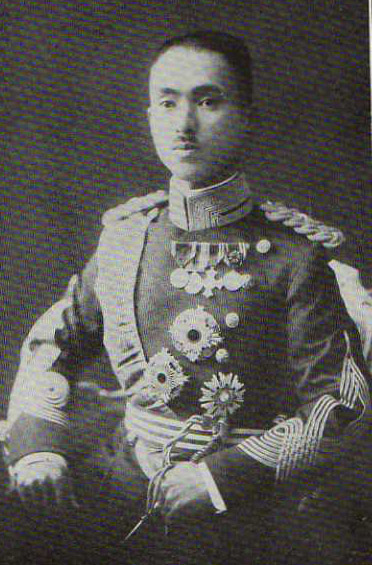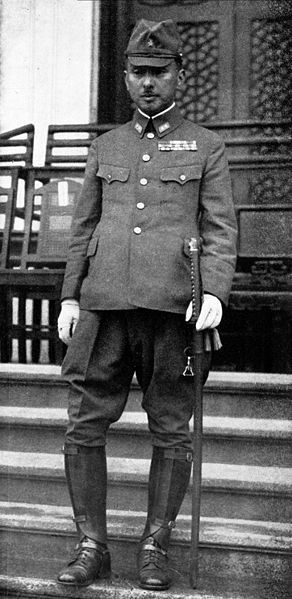<Back to Index>
- Member of the Supreme War Council Prince Yasuhiko Asaka, 1887
PAGE SPONSOR


Prince Yasuhiko Asaka (朝香宮鳩彦王 Asaka - no - miya Yasuhiko-ō, October 20, 1887 – April 12, 1981) of Japan, was the founder of a collateral branch of the Japanese imperial family and a career officer in the Imperial Japanese Army. Son - in - law of Emperor Meiji and uncle by marriage of Emperor Shōwa (Hirohito), Prince Asaka was commander of Japanese forces in the final assault on Nanking (now Nanjing), then the capital city of Nationalist China, in December 1937. He was implicated in the Nanking massacre but never charged.
Prince Yasuhiko was born in Kyoto, the eighth son of Prince Kuni Asahiko and the court lady Tsunoda Sugako. Prince Kuni Asahiko was a former Buddhist priest and minor prince descended from the Fushimi - no - miya, one the four branch houses of the imperial dynasty (shinnōke) entitled to provide a successor to the throne. In 1872, the Emperor Meiji granted him the title Kuni - no - miya and authorization to begin a new collateral branch of the imperial family. Prince Yasuhiko was a half brother of Prince Higashikuni Naruhiko, Prince Nashimoto Morimasa, Prince Kaya Kuninori and Prince Kuni Kuniyoshi, the father of the future Empress Kōjun, the consort of Emperor Shōwa.
On March 10, 1906, the Emperor Meiji granted Prince Yasuhiko the title Asaka - no - miya and authorization to begin a new branch of the imperial family. On May 6, 1909, Prince Asaka married Nobuko, Princess Fumi (August 7, 1891 – November 3, 1933), the eighth daughter of Emperor Meiji. Prince and Princess Asaka had four children:
- Princess Asaka Kikuko (紀久子, September 12, 1911 – February 12, 1989); married 1931 Marquis Nabeshima Naoyasu.
- Prince Asaka Takahiko (朝香 孚彦, October 8, 1913 – May 5, 1994); married Todo Chikako, the fifth daughter of Count Todo Takatsugu. They had 2 daughters, Fukuko and Minoko and a son Tomohiko.
- Prince Asaka Tadahito (朝香正彦, January 4, 1914 – January 1944), renounced membership in the imperial family and created Marquis Otowa, 1936. Killed in action during the Battle of Kwajalein);
- Princess Asaka Kiyoko (湛子, b. August 2, 1919 –); married Count Ogyu Yoshiatsu.
Like the other imperial princes of the Meiji period, it was expected that Prince Yasuhiko would pursue a career in the military. He received his early education at the Gakushuin Peers’ School and the Central Military Preparatory School, before graduating from the Imperial Japanese Army Academy in 1908 as a second lieutenant. Prince Asaka was promoted to captain in 1912, lieutenant colonel in 1917, and colonel in 1922.
Between 1920 and 1923, Prince Asaka studied military tactics at the École Spéciale Militaire de Saint - Cyr in France, along with his half brother Prince Higashikuni Naruhiko and his cousin Prince Kitashirakawa Naruhisa (1887 – 1923). However, on April 1, 1923, he was seriously injured in an automobile accident in a Paris suburb that killed Prince Kitashirakawa and left Prince Asaka with a limp for the rest of his life.
Princess Asaka traveled to France to nurse her husband. Prince and Princess Asaka also visited the United States in 1925. During that period, Prince and Princess Asaka became enthralled with the Art Deco movement. Upon returning to Japan in 1925, Prince Asaka had a new mansion built in the Art Deco style in Tokyo's Shirokanedai neighborhood. The house was completed in May 1933, but Princess Asaka died a few months later.
Prince Asaka was promoted to the rank of Colonel in 1926. He rose to the rank of major general and was appointed an instructor at the Army Staff College in 1930. In 1933, he was promoted to lieutenant general and assumed command of the First Imperial Guards Division. In December 1935, he was appointed a member of the Supreme War Council, which gave him a very influential position with Emperor Hirohito.
However, during the abortive February 26 Incident Prince Asaka pressed the Emperor to appoint a new government that would be acceptable to the rebels, especially by replacing Prime Minister Okada Keisuke with Hirota Koki. The Prince's pro-Imperial Way Faction political sentiments, as well as his connections to other right wing army cliques, caused a rift between himself and the Emperor. It was perhaps due to this rift that Prince Asaka was transferred to the Japanese Central China Area Army (under elderly General Matsui Iwane) in China in 1937.
In November 1937, Prince Asaka became temporary commander of the Japanese forces outside Nanking (or Nanjing), then capital of China, because General Matsui was ill. As temporary commander of the final assault on Nanking between December 2 and 6, 1937, he allegedly issued the order to "kill all captives", thus providing official sanction for what became known as the "Nanking Massacre" or the "Rape of Nanking" (December 12, 1937 – February 10, 1938). However the order may have actually been issued, with the Prince's knowledge or assent, by Lieutenant Colonel Isamu Chō. He was a known radical ultra - nationalist staff member of the Central China Area Army who may have released the order under the sign manual of Asaka.
Even if Chō took the initiative on his own, Prince Asaka, who was nominally the officer in charge, gave no orders to stop the carnage. General Matsui did not arrive in the city until well after the killing had begun but similarly did not issue orders to stop the atrocities.
While Prince Asaka's responsibility for the Nanking Massacre remains a matter of debate, the sanction for the massacre and the crimes committed during the invasion of China might ultimately be found in the ratification, made on August 5, 1937 by Emperor Hirohito, of the proposition of the Japanese army to remove the constraints of international law on the treatment of Chinese prisoners.
In February 1938, with Nanking destroyed, both Prince Asaka and General Matsui were recalled to Japan. Matsui went into virtual retirement, but Prince Asaka remained on the Supreme War Council until the end of the war in August 1945. He was promoted to the rank of general in August 1939 but held no further military commands. In 1944, he colluded with Prince Higashikuni, his nephew Prince Takamatsu, and former Prime Minister Konoe Fumimaro (1895 – 1945) to oust the Hideki Tojo cabinet.
SCAP officials interrogated Prince Asaka about his involvement in the Nanking Massacre on May 1, 1946, but did not bring him before the International Military Tribunal for the Far East for prosecution. Indeed, for politico - strategic and geopolitical reasons, General Douglas MacArthur decided to support the Imperial family and to grant immunity to all its members.
On October 14, 1947, Asaka Yasuhiko and his children lost their imperial status and privileges and became ordinary citizens, as part of the American Occupation's abolition of the collateral branches of the Japanese Imperial family. He and his son were purged from holding any political or public office because they had been officers in the Imperial Japanese Army. His Art Deco mansion in Shirokanedai was seized by the government, and now houses the Tokyo Metropolitan Teien Art Museum.
The former prince, Asaka Yasuhiko, moved to Atami, on the Izu Peninsula south of Tokyo. Asaka converted to Roman Catholicism on December 18, 1951, and was the first member of the Imperial Family to do so. He spent most of his time playing golf. He also took an active interest in golf course development, and in the 1950s was the architect of the Plateau Golf Course at the Dai - Hakone Country Club. Asaka Yasuhiko died of natural causes on April 13, 1981 at his home in Atami, Shizuoka prefecture. He was 93 years old.